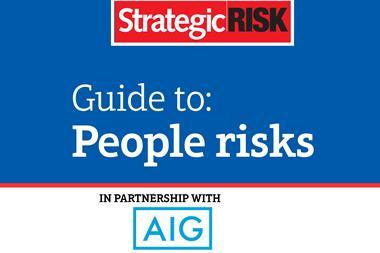Increasing amounts of data are giving companies the opportunity to model staff trends more efficiently

The amount of data generated by businesses about their employees has increased massively, and one of the most promising areas of potential collaboration between risk managers and human resources is around the use of analytics and Big Data.
“We all do a lot of work gathering employee opinions through surveys, but how many firms really interrogate the data to get genuine insights?” says Yves Duhaldeborde, director, talent and rewards at Willis Towers Watson. “I’m very interested in the way we can use Big Data and analytics to make sense of our data and its effects on risk. Talent management and human capital are obvious areas where this approach can really help.
“As an example, I was talking to an employee who has just joined us and it struck me: if his previous employer had understood his background better, his ambitions, where he was in his career, what training he had – or hadn’t – had, then he wouldn’t necessarily have left that company to work for us.” Recruitment and replacing talent has cost implications for businesses, he adds.
“If HR and risk managers look at these factors, then they can begin to model the likelihood of an individual leaving at particular points in their career. They might find that training on a particular topic after an individual joins a firm might mean companies are more likely to retain talent for another two years, for example. But this isn’t done.”
Generally, a firm might know what training an employee is getting and how their salary is progressing – businesses are, after all, capturing that data in one form or another. The problem is that they are not modelling it. “Companies are not working the data and using analytical tools to really interrogate this information, nor are they using that intelligence to make decisions,” says Duhaldeborde.
Analytics has widespread applications across managing human risk, particularly in health and safety. Many companies have gone to great efforts to develop their safety culture, of course. But establishing how successful they have been can be difficult. What needs to be done beyond standard risk management is using analytical tools to extrapolate what this information can tell a firm about its working practices and operations. Can businesses better predict when an accident or safety issue is likely to occur, for example?
“When one of my clients took the data gathered through staff surveys and ran it through a series of analytical tools, they were able to find out that one particular unit was very unhappy about their safety arrangements,” says Duhaldeborde.
“When this was looked at in more detail, it became clear that there was a serious risk of death in this unit because its safety culture had developed to such an extent that its safety procedures were no longer viable.”
Having learned this, risk management and human resources were able to work together to remedy the situation.
“By sharing information across functions openly, these units were able to identify trends that they may well have missed individually,” says Duhaldeborde. “This is about active listening.”
He adds: “There is a need for close collaboration, not only to anticipate problems, but also to develop the culture of the company and find values that will help eliminate risk, particularly reputational risk.”
Technically advanced
This approach has been made possible thanks to recent technical developments and advances in analytics tools. “Take the example of large organisations with hundreds of employees across many countries,” says Duhaldeborde.
“In the past, the kind of qualitative comments that these businesses would get back from staff surveys were very hard to analyse.” They may have been in different languages or in the form of long pieces of text. Numerical analytical tools did not have much to offer a decade ago. “But now, there are tools that enable leaders to access data in a meaningful way and find patterns that provide real insight into how employees are feeling and how this varies across the organisation,” says Duhaldeborde.
“For example, if groups of employees have lost their way on values, companies can spot that, address it and again, human resources and risk management can work together more successfully than they could on their own.
“They can also start to profile individuals, identify those thinking of leaving and ask: ‘Why? What is it that these employees are not happy about and why do they have their CV out there?’”
These tools make action possible. They can identify problems with productivity and provide the means to discuss the why: do staff need training or better equipment? “Businesses can find these things out early, before the problems become critical, and do something about it,” says Duhaldeborde.
“Take, for example, a building project that requires certain skills and there is a pool of people to whom the project can be allocated. All too often, companies don’t carry out sufficient work to match the skills to the clients’ needs. It may be that the client requires a certain amount of diversity, for example. These analytical tools help companies deliver what is required and do more for their clients, which is a very positive thing to be able to offer.”
Analytics can also address future human risks that organisations may struggle with, such as workforce planning. Questions about the shape of a business, where it wants to be in the future and how it can be more sustainable can be answered. An action plan for challenges such as workforce diversity can also be developed.
“With this kind of information, not only can risk managers act with the benefit of expert help from human resources, but human resources can also draw on the experience of the risk department and get them to talk to staff and bring their perspective into day-to-day operations,” says Duhaldeborde.
“People are really keen to see an end to silo mentality and this is a really positive way of achieving this and helping the company to function in a much more collaborative way.” S




















No comments yet